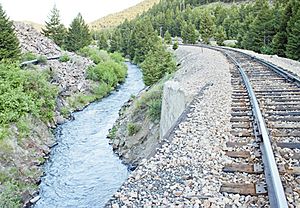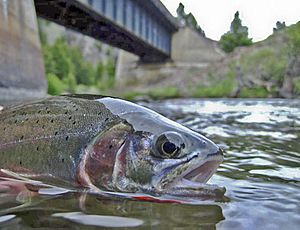Silver Bow Creek facts for kids
Silver Bow Creek is a stream about 26 miles (42 km) long. It's like the starting point for the Clark Fork River. This creek begins in the city of Butte, Montana, where two smaller creeks, Little Basin and Blacktail Creeks, join together. Another creek, Yankee Doodle Creek, used to flow into Silver Bow Creek, but now its water goes into the Berkeley Pit. Silver Bow Creek flows mostly northwest and north through a mountain valley. It passes east of Anaconda, Montana, and then joins with Warm Springs Creek to become the Clark Fork River.
For over 100 years, Silver Bow Creek was used like an open drain for factories, mostly for waste from mining and metal-making (called smelting). In 1908, a huge flood spread a lot of dangerous materials like heavy metals and arsenic all along the creek's banks. This caused big risks for nature and people's health.
Contents
Cleaning Up Silver Bow Creek: A Big Project
The area around the Upper Clark Fork River is the largest Superfund site in America. A Superfund site is a place that has been polluted and needs a special cleanup. The city of Butte, where Silver Bow Creek starts, was the main source of this pollution. This happened because of more than a century of large-scale mining and processing of ore (rock with valuable metals).
This huge Superfund cleanup area includes the cities of Butte, Anaconda, Deer Lodge, and Bonner-Milltown. The pollution stretches along a river path for about 120 miles (193 km), from Butte all the way to the Milltown Reservoir Superfund Site. It also includes nearby places like the Anaconda Smelter Stack. The main cause of this pollution was the mining and smelting work done by the Anaconda Copper Mining Corporation.
Why the Creek Needed Cleaning
The Anaconda Copper Mining Corporation (ACM) joined with another company, Atlantic Richfield Corporation (ARCO), in 1977. Not long after, in 1983, ARCO stopped all mining and smelting in the Butte-Anaconda area. For more than 100 years, ACM mined and processed metal ore in Butte. The places where they melted the ore (smelters) operated in Butte until around 1920 and in Anaconda until 1981.
In Butte, waste from the mines and smelters was dumped right into Silver Bow Creek. This created a long trail of pollution, about 120 miles (193 km) long, that went down the valley to the Milltown Dam on the Clark Fork River. Pollution carried by air and water also harmed farm animals and soil in the Deer Lodge Valley. Serious environmental cleanup efforts began in 1983 under the Superfund program, and they are still going on today.
Who is Helping with the Cleanup?
The Environmental Protection Agency (EPA) officially named Silver Bow Creek a Superfund site in 1985. They called it the Streamside Tailings (SST) Superfund site. ARCO was chosen as the main company responsible for the cleanup. In 1995, the EPA decided on a plan for cleaning up the 26-mile (42 km) long Silver Bow Creek. Soon after, the state of Montana took the lead on the cleanup and decided to combine the cleanup work with efforts to bring the area back to its natural state.
In 1983, the state of Montana also sued ARCO. They wanted money to fix the damage to the water, soil, plants, fish, and wildlife in the Upper Clark Fork River basin. In 1999, the state, federal government, and local tribes reached an agreement. Atlantic Richfield Company (ARCO) agreed to pay $215 million to the state. This money was given through the Natural Resource Damage Program to help solve some of the state's claims.
From this money, $80 million (plus interest) was set aside for the Montana Department of Environmental Quality (DEQ) and the US-EPA to carry out the cleanup plan for Silver Bow Creek. Also, the Greenway Service District got $23.5 million to improve the cleanup of Silver Bow Creek by adding restoration efforts. So far, DEQ, the Natural Resource Damage Program, and the Greenway Service District have worked together successfully to clean up and restore about 70% of the Silver Bow Creek area. The plan is for this area to be used for recreation in the future, which will help protect these efforts for many years.
Bringing Nature Back
The cleanup of Silver Bow Creek was planned to be finished in 2014. The work to clean up and restore Silver Bow Creek is the biggest project of its kind in the United States. It has won awards from local, national, and even international groups for its excellent environmental work. Right now, the cleanup and restoration of the last part of the creek, called Durant Canyon, is happening.
One important sign that Silver Bow Creek is getting healthy again is the presence of Westslope cutthroat trout. This is a native fish species and Montana's state fish. These trout are at the top of the food chain in the creek, so if they are doing well, it means the creek is recovering successfully.



